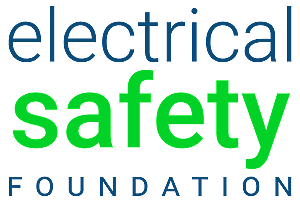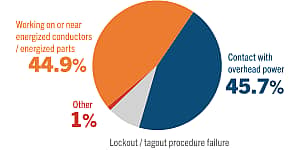
ESF’s article, The Importance of Electrical Safety Education for the Construction Trades, was recently featured in Workplace Material Handling & Safety Magazine. Read the article here.
“Working on a construction job site can be incredibly dangerous if workers are not adequately trained to conduct their jobs safely and learn how to avoid preventable safety hazards. According to the Occupational Safety and Health Administration (OSHA), the construction industry has one of the highest rates of workplace injuries and deaths in the U.S.
Year after year, contact with or exposure to electricity continues to be one of the leading causes of these injuries. Of the total 1,322 workplace electrical fatalities reported to OSHA between 2011 and 2022, 70% of all fatalities occurred in non-electrically related occupations. This statistic shows workers must be educated on basic electrical safety principles when working around electricity.
In looking further at the occupations involved in electrical fatalities as reported to OSHA, the occupations with the most electrical fatalities included those usually found on construction sites:
- Construction laborers: 119 fatalities
- Tree trimming occupations: 94 fatalities
- Heating, air conditioning, and refrigeration mechanics: 42 fatalities
- Heavy truck drivers: 35 fatalities
- Roofers: 29 fatalities
- Construction and maintenance painters: 28 fatalities
According to OSHA, the most common cause of workplace fatalities for these trades occurred from contact with overhead power lines. This was the cause for 84% of tree trimmers, 81% of roofers, 78% of painters in construction and maintenance, 76% of heavy truck drivers, and 60% of construction laborers.
Another 35% of construction laborer workplace fatalities were caused by working on or near energized equipment or wires. Ninety percent of the workplace electrical fatalities happening to heating, air conditioning, and refrigeration mechanics were caused by contact with or working near energized conductors or parts, while 60% of these fatalities occurred while a mechanic was troubleshooting or testing a device.
The OSHA Fatal Four
The leading causes of construction workplace fatalities, also known as the OSHA Fatal Four, include electrocution, falls from heights, struck-by, and caught-in between. Many fatalities occur from workers accidentally coming in contact with energized equipment or parts near them. To stay safe on the job site, always stay away from and be aware of energized equipment or parts near you or your equipment. Do not operate portable electric tools unless they are grounded or double-insulated, and always use ground-fault protection. If you’re working on a job that requires you to dig, always call 811 to locate any underground wires before starting work.
To prevent electrocution, locate and identify utilities, such as overhead power lines, when operating any equipment and maintain the following safe distances from power lines:
- <50v – 46 kilovolts (kV): 10 feet safe distance
- 41 kV – 169 kV: 10-12 feet safe distance
- 230 kV – 362 kV: 13-16 feet safe distance
- 500 kV – 800 kV: 19-24 feet safe distance
To prevent falls from heights, always wear personal fall arrest equipment, and always cover and secure floor openings and label floor opening covers. Be sure to install and maintain perimeter protection and use ladders and scaffolds safely. To prevent being struck by equipment, never position yourself between moving and fixed objects. Always wear high-visibility clothes near equipment and vehicles. To avoid being caught in or between equipment, never enter an unprotected trench or excavation five feet or deeper without adequate protective systems in place. Some trenches or excavations under five feet deep may also require protection. Make sure the trench or excavation is protected by either sloping, shoring, benching, or trench shield systems.
The Hierarchy of Controls
It is imperative to follow the hierarchy of controls before starting any job to keep yourself safe from preventable hazards. If you’re ever unsure about having the required expertise to conduct a job or about how to conduct a procedure safely, know when to stop and say something to your supervisor. By assessing your own knowledge and skills, you protect yourself as well as those around you.
Also, remain aware of potential electrical hazards in the workplace. Avoid electrical rooms and other potentially hazardous areas. All electrical work should be completed by qualified workers with proper training who understand the limits of their qualifications. Workers, especially the construction trades most likely to be injured by overhead power lines, or those working on or near energized equipment or wires, need to be educated about the hazards of working near electricity and provided with information to keep themselves safe.
When workers are prepared and educated about how to safely conduct their jobs, work will be completed correctly, which will avoid injuries, fatalities, and potential OSHA fines.”







